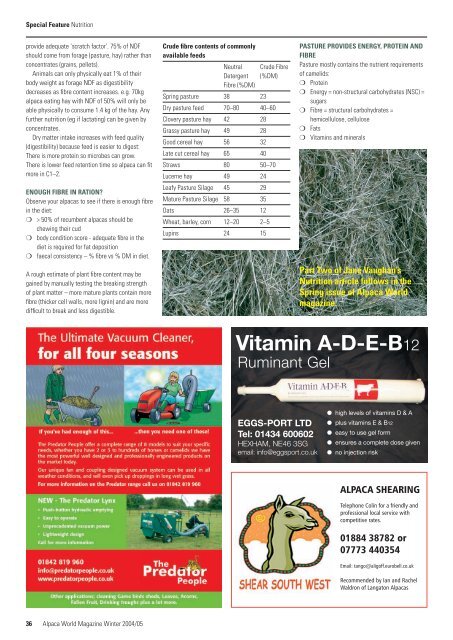You also want an ePaper? Increase the reach of your titles
YUMPU automatically turns print PDFs into web optimized ePapers that Google loves.
Special Feature Nutrition<br />
provide adequate ‘scratch factor’. 75% of NDF<br />
should come from forage (pasture, hay) rather than<br />
concentrates (grains, pellets).<br />
Animals can only physically eat 1% of their<br />
body weight as forage NDF as digestibility<br />
decreases as fi bre content increases. e.g. 70kg<br />
alpaca eating hay with NDF of 50% will only be<br />
able physically to consume 1.4 kg of the hay. Any<br />
further nutrition (eg if lactating) can be given by<br />
concentrates.<br />
Dry matter intake increases with feed quality<br />
(digestibility) because feed is easier to digest:<br />
There is more protein so microbes can grow.<br />
There is lower feed retention time so alpaca can fi t<br />
more in C1–2.<br />
ENOUGH FIBRE IN RATION?<br />
Observe your alpacas to see if there is enough fi bre<br />
in the diet:<br />
❍ > 50% of recumbent alpacas should be<br />
chewing their cud<br />
❍ body condition score - adequate fi bre in the<br />
diet is required for fat deposition<br />
❍ faecal consistency – % fi bre vs % DM in diet.<br />
A rough estimate of plant fi bre content may be<br />
gained by manually testing the breaking strength<br />
of plant matter – more mature plants contain more<br />
fi bre (thicker cell walls, more lignin) and are more<br />
diffi cult to break and less digestible.<br />
36 Alpaca World Magazine <strong>Winter</strong> 2004/05<br />
Crude fi bre contents of commonly<br />
available feeds<br />
Neutral Crude Fibre<br />
Detergent<br />
Fibre (%DM)<br />
(%DM)<br />
Spring pasture 38 23<br />
Dry pasture feed 70–80 40–60<br />
Clovery pasture hay 42 28<br />
Grassy pasture hay 49 28<br />
Good cereal hay 56 32<br />
Late cut cereal hay 65 40<br />
Straws 80 50–70<br />
Lucerne hay 49 24<br />
Leafy Pasture Silage 45 29<br />
Mature Pasture Silage 58 35<br />
Oats 26–35 12<br />
Wheat, barley, corn 12–20 2–5<br />
Lupins 24 15<br />
PASTURE PROVIDES ENERGY, PROTEIN AND<br />
FIBRE<br />
Pasture mostly contains the nutrient requirements<br />
of camelids:<br />
❍ Protein<br />
❍ Energy = non-structural carbohydrates (NSC) =<br />
sugars<br />
❍ Fibre = structural carbohydrates =<br />
hemicellulose, cellulose<br />
❍ Fats<br />
❍ Vitamins and minerals<br />
Part Two of Jane Vaughan’s<br />
Nutrition article follows in the<br />
Spring issue of Alpaca World<br />
magazine.<br />
ALPACA SHEARING<br />
Telephone Colin for a friendly and<br />
professional local service with<br />
competitive rates.<br />
01884 38782 or<br />
07773 440354<br />
Email: tango@aligoff.eurobell.co.uk<br />
Recommended by Ian and Rachel<br />
Waldron of Langaton <strong>Alpacas</strong>







